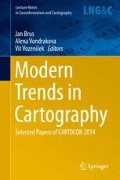Abstract
Despite of the inherent technical and ergonomic disadvantages certain need for an acoustic coding of thematic data in maps can be recognized for specific applications and users. This contribution focuses on the commonly neglected aspect of representing quantitative data. In an analytic review which mainly considers physiological and cognitive, but also implementation aspects, we will identify suitable sound variables—for representing both, data for a single point of time and time series. Based on this review the demand for future studies on sound map usability will be outlined.
Access this chapter
Tax calculation will be finalised at checkout
Purchases are for personal use only
References
Bearman N, Lovett A (2010) Using sound to represent positional accuracy of address locations. Cartogr J 47(4):308–314
Bly S (1982) Presenting information in sound. In: CHI ’82 conference on human factors in computer systems, pp 371–375
Brauen G (2006) Designing interactive sound maps: using scalable vector graphics. Cartographica 41(1):59–71
Brewster SA, Wright PC, Edwards ADN (1994) The design and evaluation of an auditory-enhanced scrollbar. In: Adelson B, Dumais ST, Olson JD (eds) Conference on human factors in computing systems, 24–28 April 1994, Boston, pp 173–179
Delogu F, Palmiero M, Federici S, Plaisant C, Zhao H, Belardinelly O (2010) Non-visual exploration of geographic maps: does sonification help? Disabil Rehabil Assist Technol 5(3):164–174
Edler D, Lammert-Siepmann N, Dodt J (2013) Die akustische Dimension in der Kartographie – eine Übersicht. Kartographische Nachrichten 62(4):185–194
Fisher PF (1994) Visualization of the reliability in classified remotely sensed images. Photogr Eng Remote Sensing 60(7):905–910
Harrower M (2007) The cognitive limits of animated maps. Cartographica 42(4):269–277
Jacobson D (2007) The future of tactile cartography: from static raised lines to multimodal dynamic portable computer interfaces. In: Abstracts of Papers. XXIII international cartographic conference, 4–10 August, Moscow, p 358
Koch WG (2012) State of the art of tactile maps for visually impaired people. In: Buchroithner M (ed) True-3D in cartography: autostereoscopic and solid visualisation of geodata. Lecture Notes in Geoinformation and Cartography. Springer, Berlin pp 137–151
Krygier JB (1993) Sound and cartographic design. Videotape. Department of Geography¸ Pennsylvania State University
Krygier JB (1994) Sound and Geographic visualization. In: MacEachren AM, Taylor DRF (eds) Visualization in modern cartography. Pergamon, pp 149–166
Lercher P (1998) Medizinisch-hygienische Grundlagen der Lärmbeurteilung. In: Kalivoda MT, Steiner JW (eds) Taschenbuch der Angewandten Psychoakustik. Springer, Wien, pp 42–102
Lodha SK et al (1996) Visualizing geometric uncertainty of surface interpolants. Graphics Interface, pp 238–245
Lodha SK, Joseph AJ, Renteria JC (1999) Audio-visual data mapping for GIS-based data: an experimental evaluation. In: Proceedings of the 1999 workshop on new paradigms in information visualization and manipulation in conjunction with the eighth ACM international conference on information and knowledge management, Kansas City, pp 41–48
Mezrich J, Frysinger S, Slivjanovski R (1984) Dynamic representation of multivariate time series data. J Am Stat Assoc 79(385):34–40
Schiewe J, Weninger B (2012) Akustische Kodierung quantitativer Information in Karten – Ergebnisse einer Studie zum Vergleich mit klassischen Darstellungsformen. Kartographische Nachrichten 62(3):126–135
Simons DJ, Ambinder MS (2005) Change blindness. Curr Dir Psychol Sci 14(1):44–48
Yeung ES (1980) Pattern recognition by audio representation of multivariate analytical data. Anal Chem 52(7):1120–1123
Author information
Authors and Affiliations
Corresponding author
Editor information
Editors and Affiliations
Rights and permissions
Copyright information
© 2015 Springer International Publishing Switzerland
About this chapter
Cite this chapter
Schiewe, J. (2015). Physiological and Cognitive Aspects of Sound Maps for Representing Quantitative Data and Changes in Data. In: Brus, J., Vondrakova, A., Vozenilek, V. (eds) Modern Trends in Cartography. Lecture Notes in Geoinformation and Cartography. Springer, Cham. https://doi.org/10.1007/978-3-319-07926-4_24
Download citation
DOI: https://doi.org/10.1007/978-3-319-07926-4_24
Published:
Publisher Name: Springer, Cham
Print ISBN: 978-3-319-07925-7
Online ISBN: 978-3-319-07926-4
eBook Packages: Earth and Environmental ScienceEarth and Environmental Science (R0)

